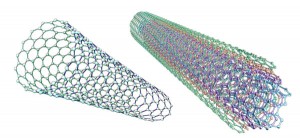What is a Carbon Nanotube?

Single- and multi-walled carbon nanotubes.
Considered one of the strongest materials known to man, carbon nanotubes possess unique structural and electrical properties that make them ideal for a wide variety of applications. Carbon Nanotubes come in two principal forms, single-walled carbon nanotubes (SWCNT) and multi-walled (MWCNT), as pictured here. Although not a hollow tube, carbon nanofibers (CNF) represent a third type of tubular structure.
A SWCNT is on the order of one nanometer, 50,000 times smaller than the diameter of a human hair, but up to several microns long. Conceptually, a SWCNT is a one-atom-thick layer of graphite, called graphene, wrapped into a seamless cylinder with either open or closed ends. As their name implies, MWCNTs consist of multiple concentric layers of graphene that form a tube shape.
SWCNTs have unique properties that make them a vital foundation for advancing device performance because they:
- Behave as a semi-conductor or metal
- Are stronger than steel, yet lighter than aluminum
- Conduct heat most efficiently
- Can easily be modified to tailor properties as an “Ink”
Due to their unique features, SWCNT form the basis for key electronic applications such as memory, semiconductor components and transparent conducting films for touch screens, displays, solar cells, sensors and other devices.
To learn more about Nano-C’s Carbon Nanotubes click here.
